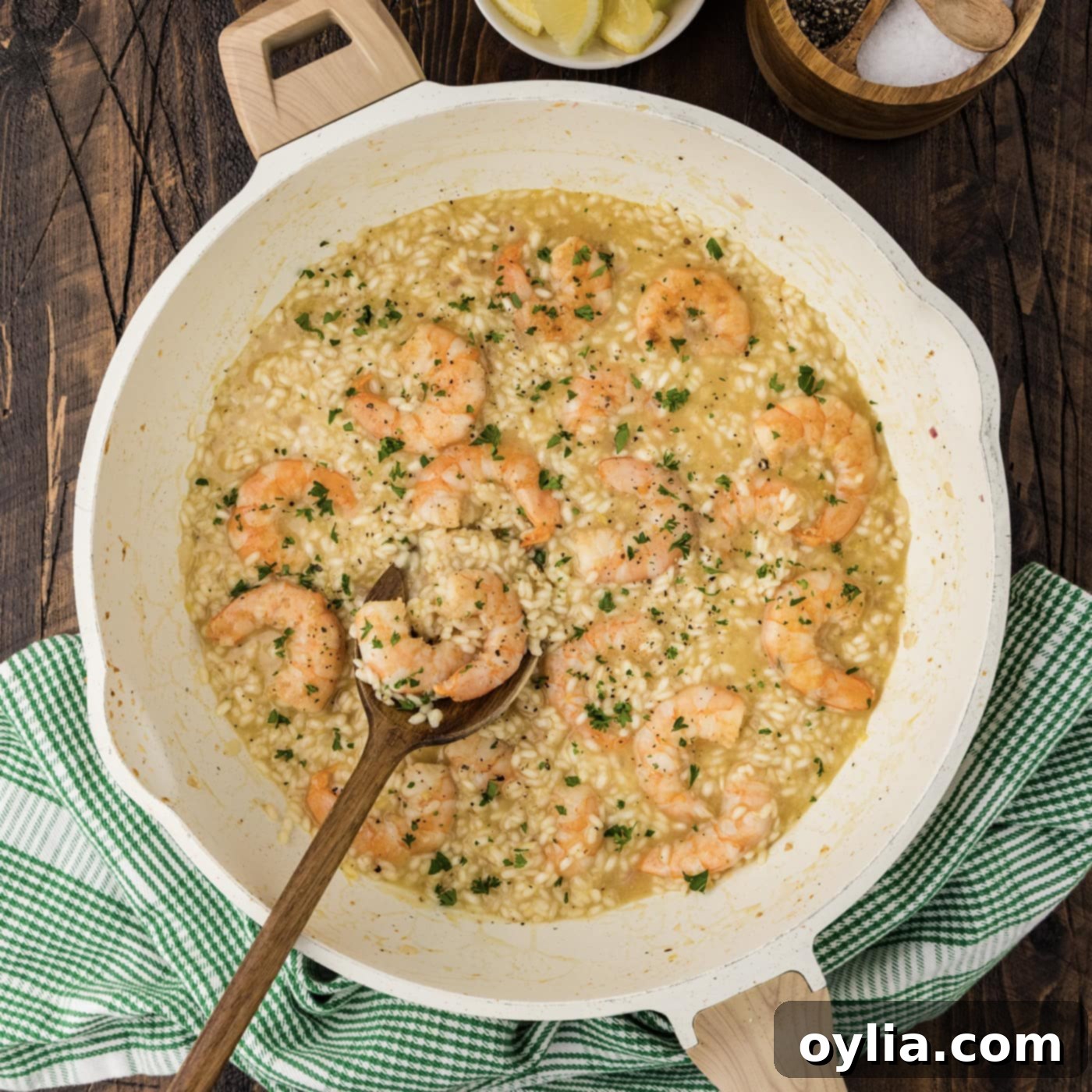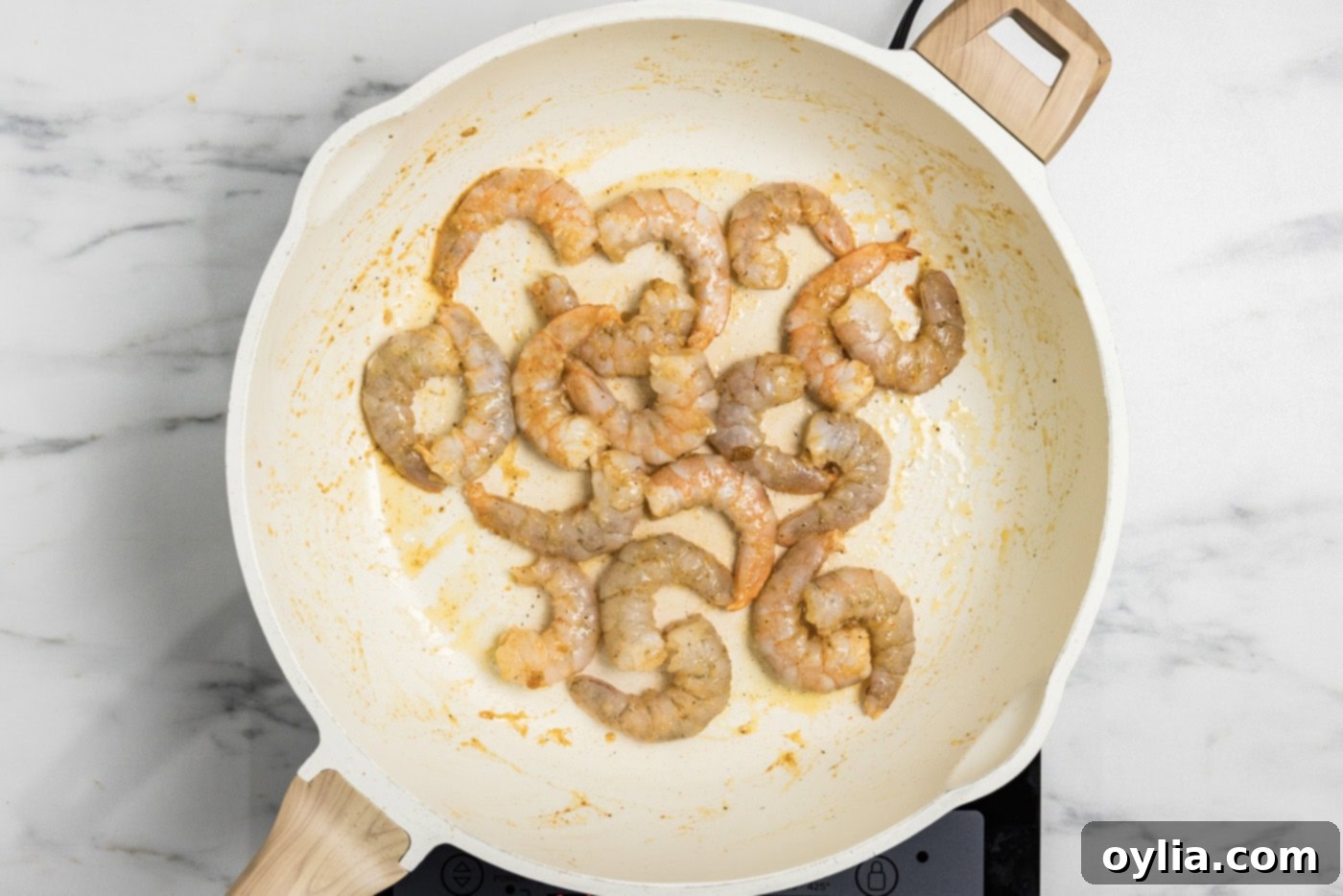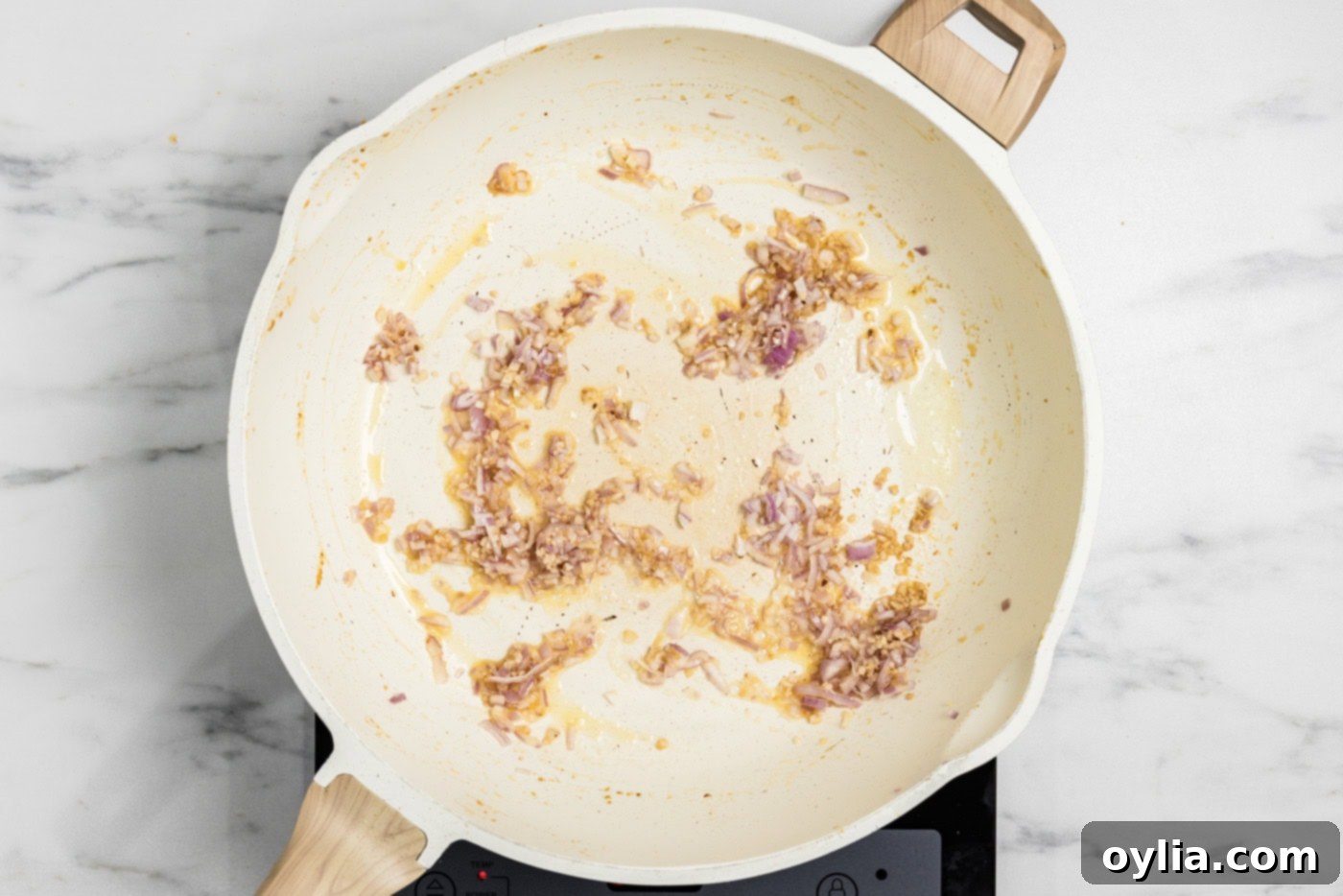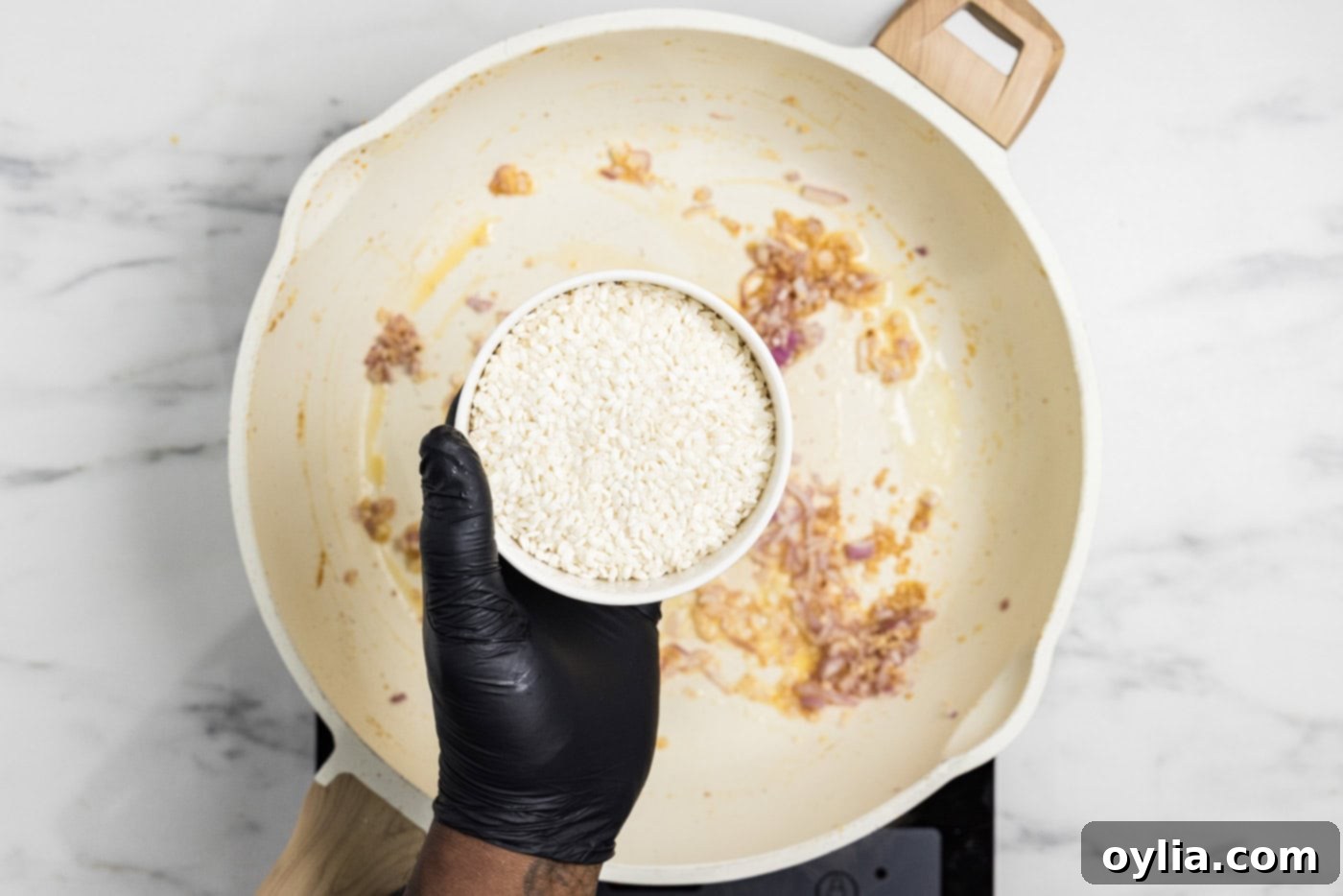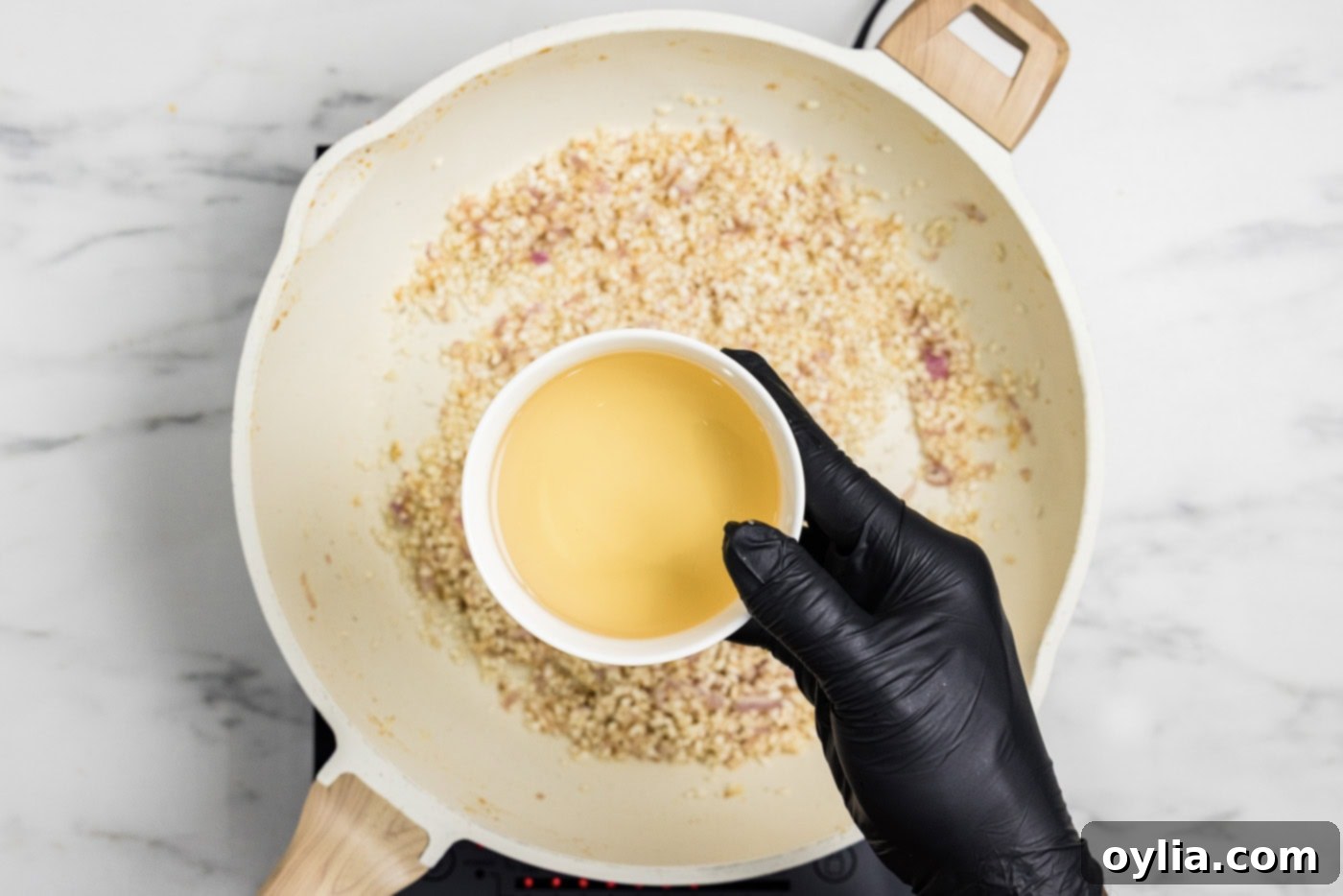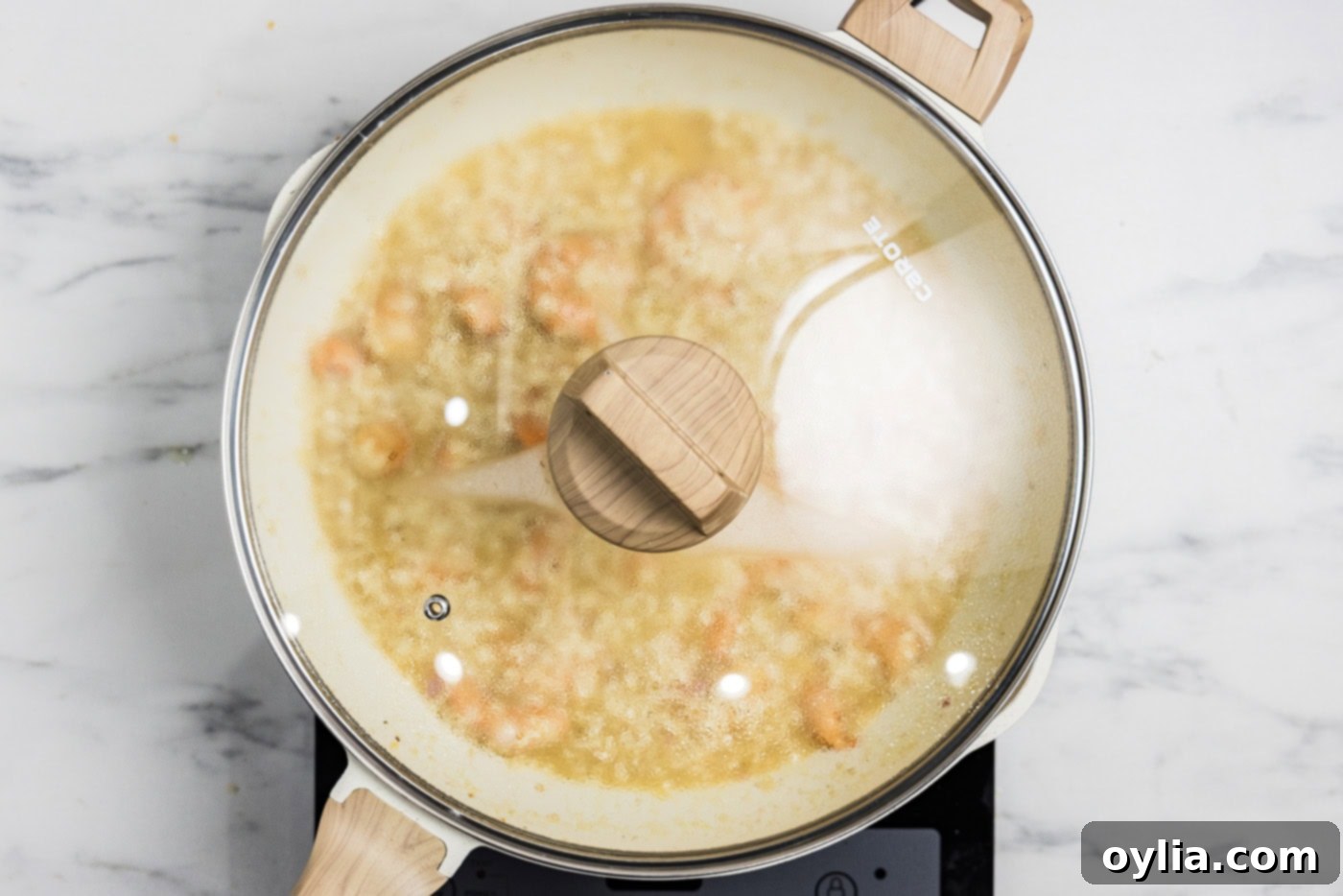Creamy Lemon Garlic Shrimp Risotto: An Easy & Elegant Seafood Delight
There’s something truly special about a well-made risotto – that luxurious, creamy texture, the delicate aroma, and the way it envelops every ingredient in its rich embrace. This Creamy Lemon Garlic Shrimp Risotto recipe is no exception. Imagine plump, succulent shrimp perfectly nestled within a bed of buttery Arborio rice, infused with the bright zest of lemon and the subtle warmth of white wine. It’s an elegant dish that feels gourmet but is surprisingly simple to master, making it perfect for both impressive dinner parties and cozy weeknight meals.

Why This Shrimp Risotto Recipe Will Become Your Favorite
Having previously shared a fantastic lobster risotto, it felt only natural to bring you an equally stellar shrimp rendition. This recipe truly shines because it effortlessly balances sophistication with ease. It’s the kind of dish that makes you feel like a culinary expert without demanding hours in the kitchen.
This shrimp risotto stands out for several reasons. First, its incredible creaminess is achieved without a heavy hand of cheese or excessive cream, relying instead on the natural starches of the Arborio rice and the classic risotto technique. Second, the flavors are bright and fresh, thanks to a generous splash of white wine and a vibrant burst of lemon juice and zest, perfectly complementing the sweetness of the shrimp. Finally, and perhaps most importantly for busy home cooks, this entire meal comes together in just about 35 minutes from start to finish. That’s quicker than many takeout options, and infinitely more delicious!
My partner, Antoine, and I absolutely adore the rich yet light texture of this dish. We’ve found that even the leftovers are a treat, which is a testament to its well-balanced flavors and consistent creaminess. Whether you’re aiming to impress guests or simply treat yourself to a comforting and elegant meal, this shrimp risotto delivers a chef’s kiss every time.
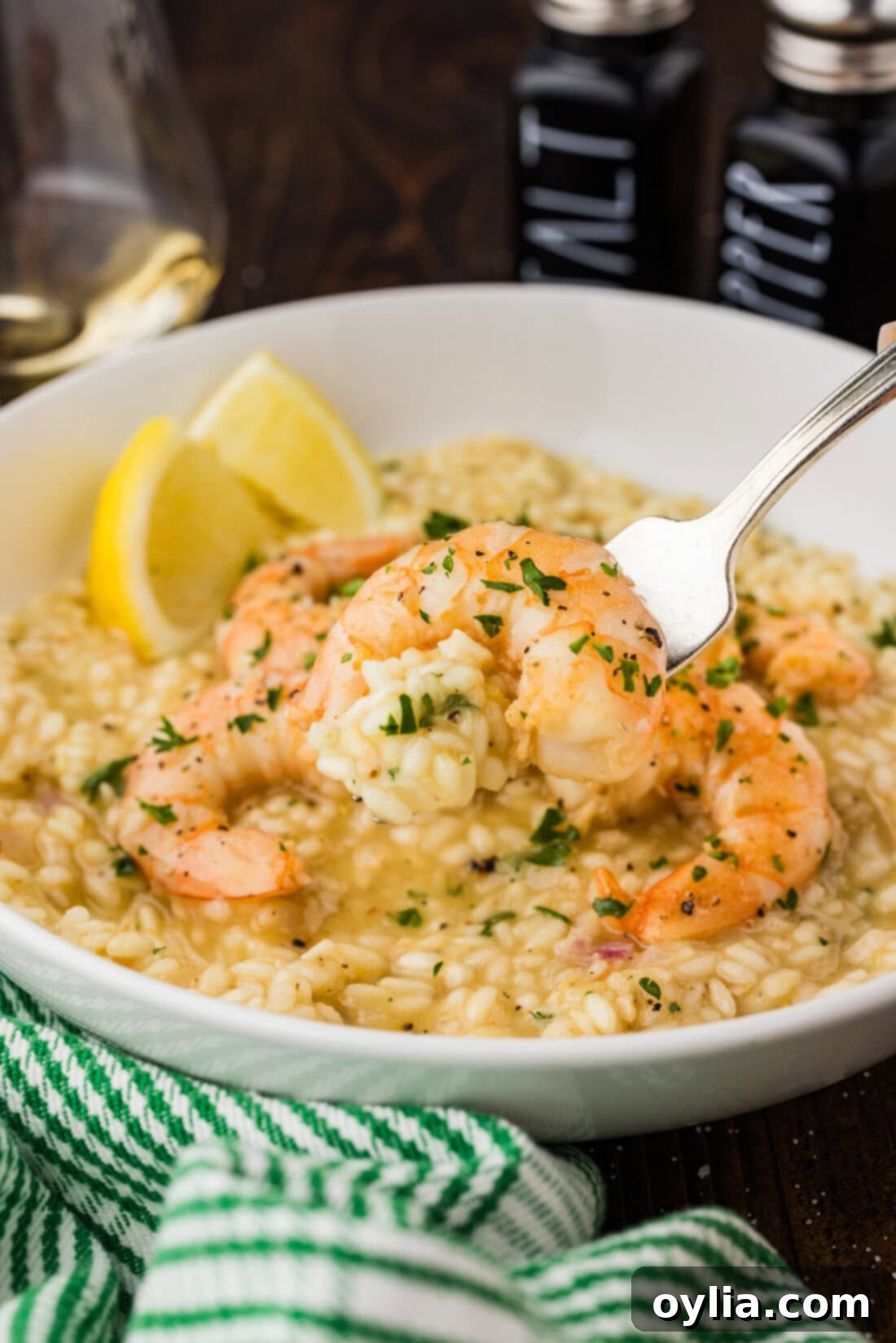
Essential Ingredients for Your Creamy Shrimp Risotto
Crafting the perfect shrimp risotto begins with selecting high-quality ingredients. While the full list of measurements and detailed instructions can be found in the printable recipe card at the end of this post, here’s a breakdown of the key components and what makes them essential for this dish.
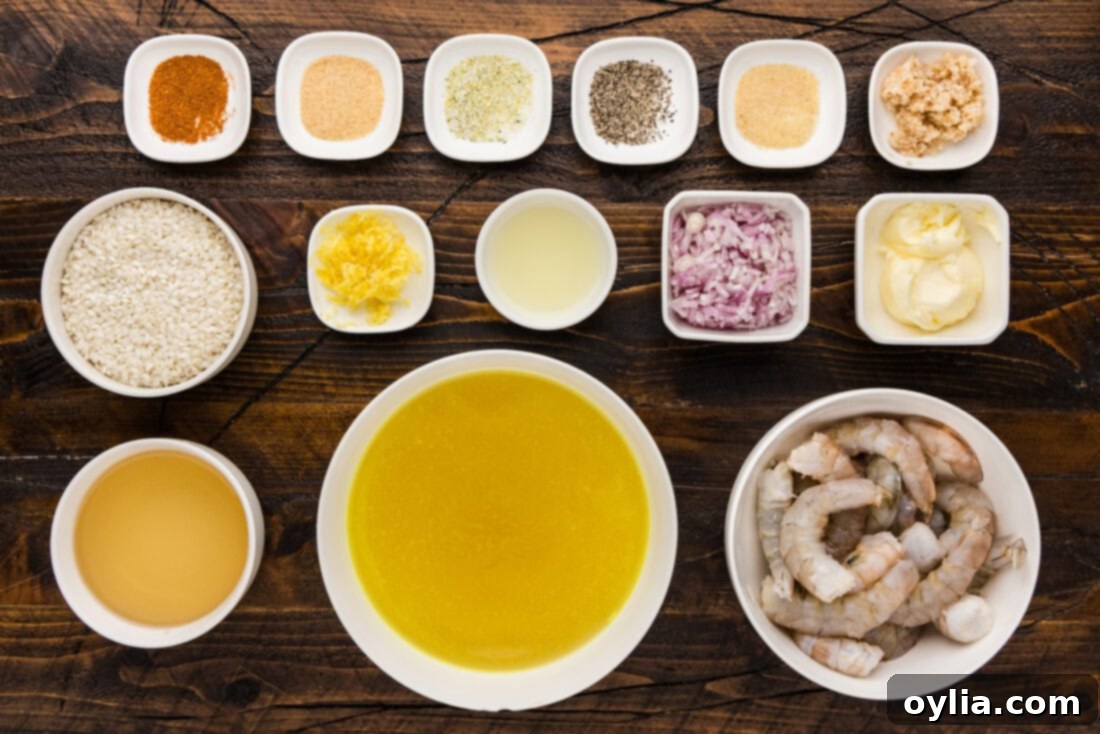
Ingredient Spotlight & Substitution Wisdom
- Shrimp: For this recipe, we recommend using large raw shrimp that has been peeled, deveined, and had the tails removed. Large shrimp ensures a satisfying bite that doesn’t get lost in the creamy rice. While fresh shrimp is ideal, high-quality frozen shrimp works perfectly too. Just remember to thaw it completely and pat it thoroughly dry before cooking to ensure it sears properly and doesn’t release excess water into your risotto.
- Risotto Rice (Arborio): The star of any risotto is the rice itself. We specifically call for Arborio rice, a short-grain Italian variety renowned for its high starch content. This starch is crucial for creating the signature creamy texture of risotto as it’s released during the cooking process. Arborio rice is widely available in most supermarkets. If you can’t find Arborio, other short-grain risotto rice varieties like Carnaroli or Vialone Nano are excellent substitutes. Avoid using long-grain rice (like Basmati or Jasmine) as it won’t yield the desired creaminess.
- Butter: Divided into two portions, butter adds a foundational richness and helps to sauté the shrimp and toast the rice, building layers of flavor.
- Aromatics (Minced Garlic & Diced Shallots): These provide the aromatic base for the risotto, imparting a delicate sweetness and depth. Shallots are milder and more subtle than onions, making them a perfect complement to the delicate shrimp and lemon flavors.
- Seasonings (Onion Powder, Garlic Powder, Old Bay Seasoning, Garlic Salt, Black Pepper): A blend of these spices enhances the shrimp and seasons the risotto. Old Bay Seasoning, in particular, adds a classic, savory, and slightly spicy seafood flavor that truly elevates the dish. Garlic salt and black pepper are essential for balancing the overall taste.
- Dry White Wine: This is a key ingredient for authentic risotto, adding acidity and depth of flavor that cuts through the richness of the butter and starch. Opt for a dry white wine such as Pinot Grigio, Sauvignon Blanc, or a dry Vermouth. Avoid sweet wines, as they will alter the flavor profile. If you prefer to cook without alcohol, you can substitute the white wine with an equal amount of chicken broth, though the depth of flavor will be slightly different.
- Chicken Broth: Warm chicken broth is gradually added to the rice, allowing the grains to slowly absorb the liquid and release their starches. Using warm broth is important because adding cold broth can shock the rice, slowing down the cooking process and potentially affecting the final texture.
- Lemon Juice & Zest: Fresh lemon juice and zest are added at the end to provide a bright, zesty finish that truly elevates the dish. The acidity of the lemon balances the richness of the risotto and enhances the natural sweetness of the shrimp. Typically, one medium lemon yields about a tablespoon of zest and 2-3 tablespoons of juice, which is perfect for this recipe.
- Fresh Parsley (Optional Garnish): A sprinkle of fresh chopped parsley adds a touch of color and a fresh herbaceous note just before serving.
Step-by-Step Guide to Making Perfect Shrimp Risotto
These step-by-step photos and instructions are here to help you visualize how to make this recipe. You can Jump to Recipe to get the printable version of this recipe, complete with precise measurements and detailed instructions at the bottom.
- Sauté the Shrimp: Begin by melting 1 tablespoon of butter in a large heavy-bottomed skillet or Dutch oven over medium-high heat until it shimmers. Add the prepared shrimp along with onion powder, garlic powder, and Old Bay Seasoning. Toss and turn the shrimp for just 1-2 minutes, or until they turn pink and begin to curl. The key here is to partially cook them, not fully, as they will finish cooking later in the risotto. Remove the partially cooked shrimp from the skillet and set them aside to keep warm.
PRO TIP: Shrimp cooks incredibly quickly. By partially cooking them now and adding them back in at the end, you prevent overcooking, ensuring your shrimp remains tender and succulent, never rubbery.

- Sauté the Aromatics: Melt the remaining 1 tablespoon of butter in the same skillet. Add the minced garlic and diced shallots. Cook, stirring frequently with a heat-resistant rubber spatula, for about 1-2 minutes, until they are softened and wonderfully fragrant. Be careful not to brown them, as this can impart a bitter flavor.

- Toast the Risotto Rice: Add the Arborio rice to the skillet with the aromatics. Stir occasionally, allowing the rice grains to toast gently until they begin to turn a light golden color and become slightly translucent around the edges, typically for 2-3 minutes. This toasting step is crucial for enhancing the nutty flavor of the rice and helping it absorb liquids more evenly, contributing to the creamy texture.

- Deglaze with White Wine: Season the toasted rice with garlic salt and black pepper. Pour in the dry white wine and stir to combine. Increase the heat slightly to bring the mixture to a boil. Reduce the heat to medium and cook for 10-15 minutes, or until the rice has absorbed most of the wine and is beginning to become tender. The wine adds a wonderful depth and acidity.

- Gradually Add Chicken Broth: Begin whisking in the warm chicken broth, adding it ½ cup at a time. Allow each addition to come to a gentle boil and be nearly fully absorbed by the rice before adding the next ½ cup. Stir frequently and consistently. Continue this process until all of the chicken broth has been added and the risotto is creamy and the rice is al dente (tender with a slight bite in the center). This gradual addition and constant stirring are what release the starches from the rice, creating that signature creamy consistency.

- Finish with Lemon and Shrimp: Once the risotto has reached its perfect creamy consistency and the rice is tender, stir in the fresh lemon juice, lemon zest, and the partially cooked shrimp. Mix everything together gently to combine. Cover the skillet with a lid and cook for just 1-2 minutes. This brief cooking time will allow the shrimp to finish cooking through without becoming tough, and the lemon flavors to meld beautifully with the creamy rice.


Frequently Asked Questions & Expert Tips for Perfect Risotto
Toasting your rice before adding liquid is a fundamental step in making excellent risotto. When the rice is toasted in a fat (like butter or olive oil, as in our case), it creates a light, protective coating around each grain. This helps the rice absorb liquids more slowly and evenly, allowing it to release its starches gradually without becoming mushy. This process also enhances the nutty flavor of the rice, contributing to a more complex and satisfying final dish. It’s akin to the Maillard reaction, developing deeper flavors.
Store any cooled leftover shrimp risotto in an airtight container in the refrigerator for up to 4 days. When chilled, risotto tends to thicken considerably due to the re-gelatinization of starches. Reheating shrimp can also be tricky, as it can easily become rubbery if overcooked. To reheat, gently warm the risotto in a saucepan or skillet over medium-low heat. Add a splash of chicken broth or water (1-2 tablespoons per serving) as needed to help loosen the risotto and restore its creamy texture. Stir frequently until heated through. Be mindful not to boil the risotto vigorously, and reheat only until warm to avoid overcooking the shrimp.
Absolutely! The dry white wine truly adds a layer of depth, acidity, and complexity to the risotto, making it taste more authentic. However, if you prefer to avoid alcohol, you can certainly swap it out for an equal amount of chicken broth. While the flavor profile will be slightly different (lacking that characteristic wine tang), the risotto will still be delicious and creamy. For the best non-alcoholic substitute, use a good quality low-sodium chicken broth.
A large, heavy-bottomed skillet or a Dutch oven is ideal for making risotto. The heavy bottom ensures even heat distribution, preventing the rice from sticking or burning. The large surface area allows the rice to spread out and cook evenly, while the high sides help contain the liquid during the stirring process. A non-stick pan can also be helpful for beginners to prevent sticking.
Yes, absolutely! Risotto is very versatile. You can add finely diced vegetables like asparagus tips, peas, or spinach during the last few minutes of cooking, just before adding the lemon and shrimp. If using heartier vegetables like mushrooms or bell peppers, sauté them with the shallots and garlic in step 2 to ensure they cook through properly.
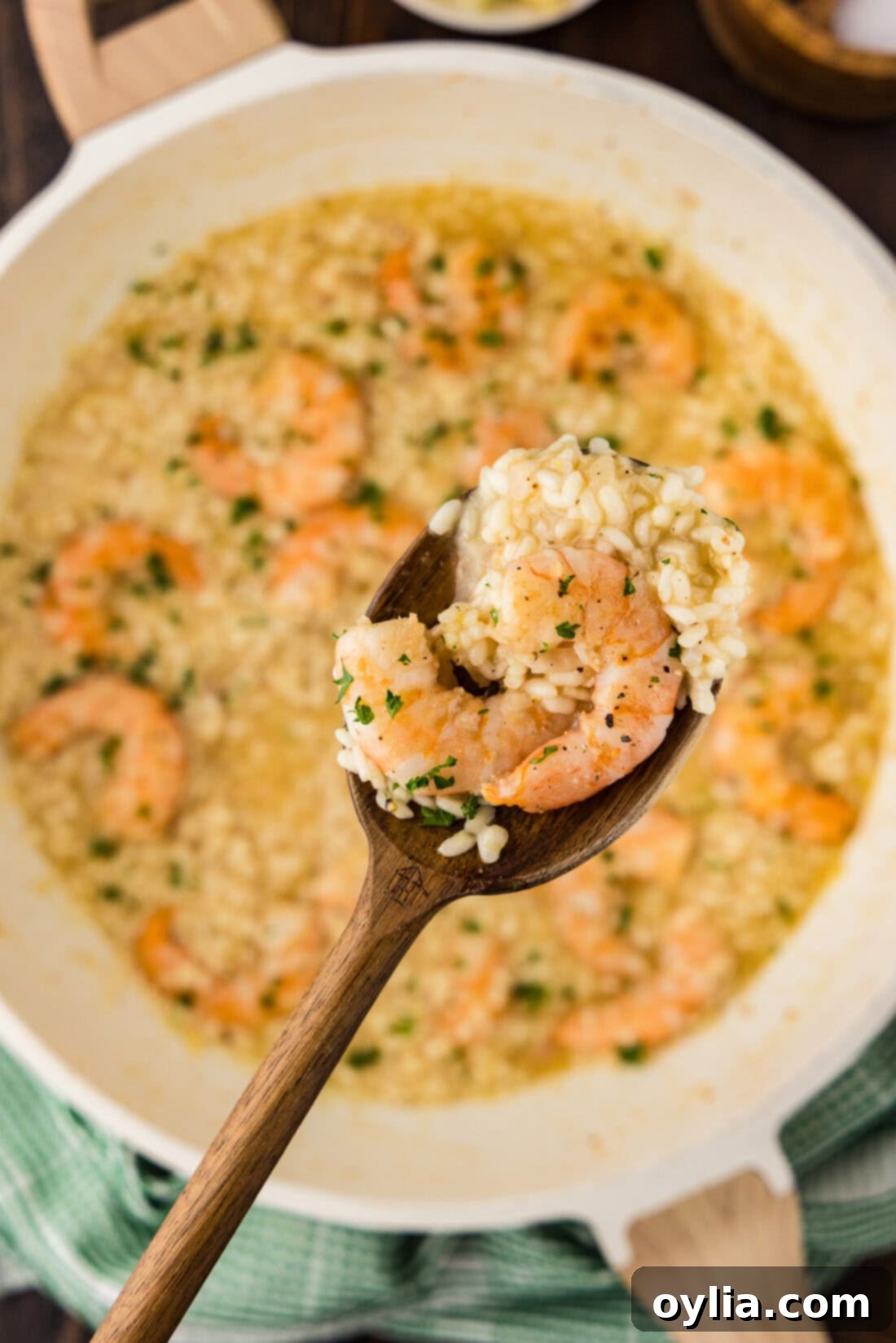
Delightful Serving Suggestions for Shrimp Risotto
Shrimp risotto is a rich and satisfying dish that can easily stand alone as a complete meal. However, it pairs beautifully with light accompaniments to create an even more enjoyable dining experience. Consider serving it alongside a crisp green dinner salad dressed with a bright vinaigrette – the acidity will complement the richness of the risotto perfectly. Roasted or steamed vegetables like tender-crisp asparagus, blanched green beans, or even some sautéed zucchini are also excellent choices, adding freshness and texture.
For a truly indulgent experience, a glass of dry white wine, such as a crisp Pinot Grigio or a refreshing Sauvignon Blanc, will enhance the flavors of both the risotto and the shrimp. If you’re hosting a dinner party, a sprinkle of freshly grated Parmesan cheese (though not traditionally added to seafood risotto in Italy, it’s a popular American addition) or a garnish of fresh parsley can add visual appeal and an extra layer of flavor.
Craving other delicious risotto options? Be sure to explore our equally dreamy asparagus risotto and creamy mushroom risotto recipes for fantastic meatless alternatives!
Discover More Irresistible Shrimp Recipes
If you love shrimp as much as we do, you’re in for a treat! Here are some other fantastic shrimp recipes that are sure to become family favorites:
- Easy & Flavorful Shrimp Pasta
- Classic Garlic Butter Shrimp
- Comforting Southern Shrimp and Grits
- Hearty Chicken and Shrimp Carbonara
I’m passionate about baking and cooking, and I love sharing my culinary adventures with all of you! To make sure you never miss a new recipe, I offer a convenient newsletter. Simply subscribe here and start receiving your free daily recipes straight to your inbox!
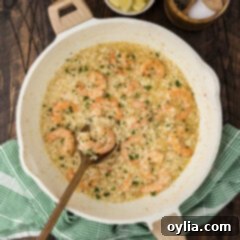
Shrimp Risotto
IMPORTANT – There are often Frequently Asked Questions within the blog post that you may find helpful. Simply scroll back up to read them!
Print It
Pin It
Rate It
Save ItSaved!
Ingredients
- 2 Tablespoons butter divided
- 12 ounces large raw shrimp peeled and deveined, tails removed
- 1 teaspoon onion powder
- 1 teaspoon garlic powder
- 1 teaspoon Old Bay seasoning
- 2 teaspoons minced garlic
- ¼ cup diced shallots
- ¾ cup risotto
- ½ teaspoon garlic salt
- ½ teaspoon black pepper
- ½ cup dry white wine
- 1 ½ cups chicken broth
- 2 Tablespoons lemon juice about 1 lemon
- 1 Tablespoon lemon zest about 1 lemon
- parsley optional as garnish
Things You’ll Need
-
Large heavy bottomed skillet
-
Heat resistant rubber spatula
Before You Begin
- Typically, one medium lemon will yield about a tablespoon of zest and 2-3 tablespoons of juice. Always zest your lemon before juicing it, as it’s much easier!
- Risotto is a short grain rice. A common substitute for it is called Arborio rice and should be available at most supermarkets. Its high starch content creates a nice creamy texture to your finished dish.
- Dry white wine is ideal here. Opt for Pinot Grigio, dry Vermouth, or Sauvignon Blanc so you aren’t adding any sweetness to the mix. If needed, you can substitute the wine with equal amounts of chicken broth.
- Make sure your chicken broth is warm before adding it to the risotto. This helps maintain a consistent cooking temperature for the rice and ensures a smoother, more even absorption, contributing to a creamier final product.
Instructions
-
Melt 1 tablespoon of the butter in skillet over medium-high heat until shimmering.
-
Add the shrimp, onion powder, garlic powder, and Old Bay Seasoning to the skillet. Toss and turn for 1-2 minutes or until they turn pink and begin to curl. Remove partially cooked shrimp and keep warm.
TIP – Shrimp cooks very quickly, therefore we are partially cooking it then adding it back in later to finish cooking. This way you won’t have rubbery shrimp in your finished dish.
12 ounces large raw shrimp, 1 teaspoon onion powder, 1 teaspoon garlic powder, 1 teaspoon Old Bay seasoning -
Melt remaining 1 tablespoon of butter in the skillet.
-
Add in garlic and shallots and cook, stirring often, until softened and fragrant, about 1-2 minutes.2 teaspoons minced garlic, 1/4 cup diced shallots
-
Add risotto and stir occasionally, until grains begin to turn light golden in color.3/4 cup risotto
-
Season with garlic salt and pepper. Add in white wine and stir to combine. Bring to a boil. Turn down to medium and cook for 10-15 minutes, or until risotto is tender.1/2 teaspoon garlic salt, 1/2 teaspoon black pepper, 1/2 cup dry white wine
-
Whisk in chicken broth, 1/2 cup at a time, allowing mixture to come to a boil, continue adding chicken broth until all broth has been added. Bring mixture to a boil.1 1/2 cups chicken broth
-
Add lemon juice, lemon zest, and partially cooked shrimp. Stir everything together and cover skillet with lid. Cook for 1-2 minutes.2 Tablespoons lemon juice, 1 Tablespoon lemon zest
Expert Tips & FAQs
- Store cooled leftovers in an airtight container kept in the refrigerator for up to 4 days. For best results, consume within 2-3 days for optimal texture and flavor.
- Risotto tends to thicken when chilled, and it can be tricky to reheat shrimp. I would suggest placing the risotto in a saucepan or skillet and gently heating it over medium-low heat. Add a splash of broth or water to help loosen as needed. This will restore some of its original creaminess.
- Don’t be afraid to taste and adjust seasonings throughout the cooking process. A pinch more salt, pepper, or a squeeze of lemon at the end can make a significant difference.
- The consistency of risotto should be “all’onda” – like a wave. It should flow slightly when you shake the pan, not be too stiff or too soupy. This comes with careful monitoring of liquid absorption.
- For an even richer risotto (optional), stir in 1-2 tablespoons of grated Parmesan cheese or a dollop of mascarpone at the very end, just before serving, after removing it from the heat.
Nutrition
The recipes on this blog are tested with a conventional gas oven and gas stovetop. It’s important to note that some ovens, especially as they age, can cook and bake inconsistently. Using an inexpensive oven thermometer can assure you that your oven is truly heating to the proper temperature. If you use a toaster oven or countertop oven, please keep in mind that they may not distribute heat the same as a conventional full sized oven and you may need to adjust your cooking/baking times. In the case of recipes made with a pressure cooker, air fryer, slow cooker, or other appliance, a link to the appliances we use is listed within each respective recipe. For baking recipes where measurements are given by weight, please note that results may not be the same if cups are used instead, and we can’t guarantee success with that method.
